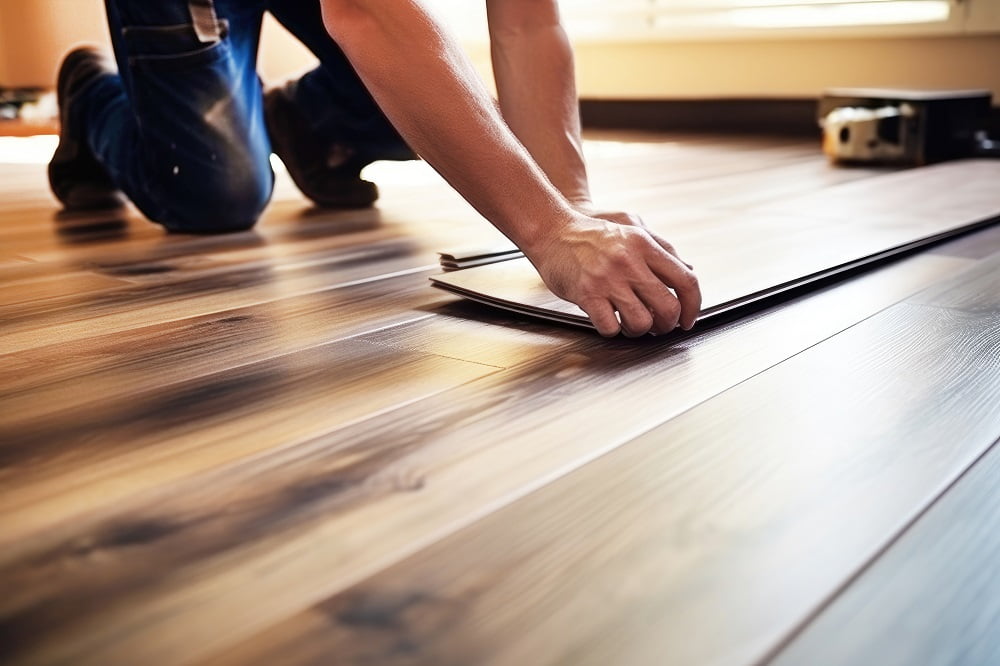Hardwood floors are beautiful, durable and luxurious. While everyone loves its stunning appearance, there’s a debate about the best way to lay it down. Homeowners have various choices when it comes to hardwood flooring placement. You can lay it vertically, horizontally, or diagonally, providing different options. Another option to consider is the herringbone pattern. Before updating your flooring, it’s essential to pause and carefully consider all these options.
Aligning the planks parallel to the longest wall is the most common way to lay hardwood flooring. It is the preferred direction to lay wood floors because it looks aesthetically pleasing and provides the best results. However, there are other options. You should also consider the room in which hardwood flooring will be installed, along with your entire floor plan, to ensure your flooring looks cohesive throughout your home.
One of the most important factors to consider when installing new hardwood flooring is your light source. If the room has a lot of natural light, consider running the boards in the direction of the light. If the planks are laid perpendicular to the light source, the light will run across each joint, and any slight variation in the height of your boards will become visible and cast a small shadow. Running your hardwood planks in the same direction as the light source will eliminate this problem and result in a more aesthetically pleasing floor.
Here are some flooring direction options explained in detail:
Straight
Hardwood floors are typically laid in a straight pattern, and planks are installed parallel to each other along the length of your room to achieve this look. This pattern is both classic and stylish and works with almost any design aesthetic. A straight pattern is tried and true and can lengthen the look of a room.
Running a straight pattern lengthwise from your front door back will make a hallway appear longer instead of a horizontal pattern running across.
Horizontal
If your room is narrow, you can choose to run your flooring horizontally because this will make your space seem larger than it is. It will draw the eye from side to side, creating a greater perception of space.
Herringbone
In the traditional herringbone pattern, wood planks are laid in a diagonal zigzag pattern. This is a very classic pattern that will never go out of style, and herringbone will make a statement in any space.
Since this design is complex, there are a few things you will need to consider before the installation process. You will need to hire an experienced installer who knows how to create this type of pattern. You will also need to be prepared for a higher installation fee. Due to the way this pattern is precisely cut, there will be some additional waste, which will increase your cost slightly. Additionally, installers will charge more for this pattern because laying herringbone is more complex.
Diagonal
If you want a pattern that is slightly different from straight flooring but doesn’t want to take a huge leap, you can consider installing hardwood flooring on a diagonal. This will look great in any room and will have a significant visual impact on the room’s appearance because the space will feel larger.
Pattern
Laying the wood planks in repeated geometric patterns can help you achieve an endless number of flooring designs. You can choose a simple pattern or a more complicated parquet floor pattern with the look of a checkerboard or other design modules.
A pattern will require careful planning, but it can enhance the appearance of any room and create that wow factor in your home.
Random Width
This pattern involves a mixture of boards with different widths, although they are a straight-forward parallel design. This kind of hardwood flooring pattern will allow you to choose the ratio of wide and narrow boards, which can result in a customized look. If you are interested in a more rustic feel, this pattern will help you achieve that goal.
Installation Methods
Once you decide how you’d like to lay your hardwood floors, you must consider the different installation methods. There are various options, including nail down, staple down, glue down or floating, and it is highly recommended that you hire professional installers for this task. They will complete the process quickly and professionally and will provide you with the results you want.
- Nail down – Nails are used to fasten the wood to the subfloor, a common method used to install thin wood flooring.
- Staple down – Staples are used instead of nails to attach the floor to the subfloor, which is easier than the nail-down method.
- Glue down – Engineered wood floors and parquets can be glued down to the subfloor with a strong adhesive.
- Floating – These floors are not attached to any subfloor and simply float above it. This is the fastest and easiest installation method. In this case, either adhesive is applied to the boards to keep them together, or the boards are made to snap together. A pad is usually placed between the wood floor and the subfloor to protect against moisture and reduce noise. These floors can be installed over almost any surface.
Skill and experience are required to install hardwood flooring. It’s best to hire professional hardwood flooring installers like us who help you get the job done efficiently! At Milton Hardwood, offer a beautiful collection of hardwood flooring options. Our skilled professionals help you figure out how your hardwood flooring can be installed.
Contact us today to install the perfect hardwood flooring for your dream project!






